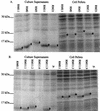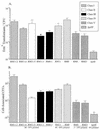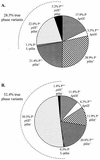Comparisons between colony phase variation of Neisseria gonorrhoeae FA1090 and pilus, pilin, and S-pilin expression
- PMID: 9573070
- PMCID: PMC108144
- DOI: 10.1128/IAI.66.5.1918-1927.1998
Comparisons between colony phase variation of Neisseria gonorrhoeae FA1090 and pilus, pilin, and S-pilin expression
Abstract
The gonococcal pilus is a primary virulence factor, providing the initial attachment of the bacterial cell to human mucosal tissues. Pilin, the major subunit of the pilus, can carry a wide spectrum of primary amino acid sequences which are generated by the action of a complex antigenic variation system. Changes in the pilin amino acid sequence can produce different pilus-dependent colony morphotypes, which have been previously shown to reflect phase variation of pili on the bacterial cell surface. In this study, we further examined the relationships between changes in pilus-dependent colony morphology, pilin sequence, pilus expression, and pilus function in Neisseria gonorrhoeae FA1090. A group of FA1090 colony variants expressed different pilin sequences and demonstrated different levels of pilin, S-pilin, and pilus expression. The analysis of these colony variants shows that they do not represent two distinct phases of pilus expression, but that changes in pilin protein sequence produce a spectrum of S-pilin production, pilus expression, and pilus aggregation levels. These different levels of pilus expression and aggregation influence not only colony morphology but also DNA transformation efficiency and epithelial cell adherence.
Figures






References
-
- Arminjon F, Cadoz M, Morse S A, Rock J P, Sarafian S K. Abstracts of the 87th Annual Meeting of the American Society for Microbiology 1987. Washington, D.C: American Society for Microbiology; 1987. Bactericidal and opsonic activities of sera from individuals immunized with a gonococcal protein I vaccine, abstr. E-92; p. 118.
-
- Bollag D M, Edelstein S J. Protein methods. New York, N.Y: John Wiley & Sons, Inc.; 1991.
Publication types
MeSH terms
Substances
Associated data
- Actions
- Actions
- Actions
- Actions
- Actions
- Actions
- Actions
- Actions
- Actions
Grants and funding
LinkOut - more resources
Full Text Sources

